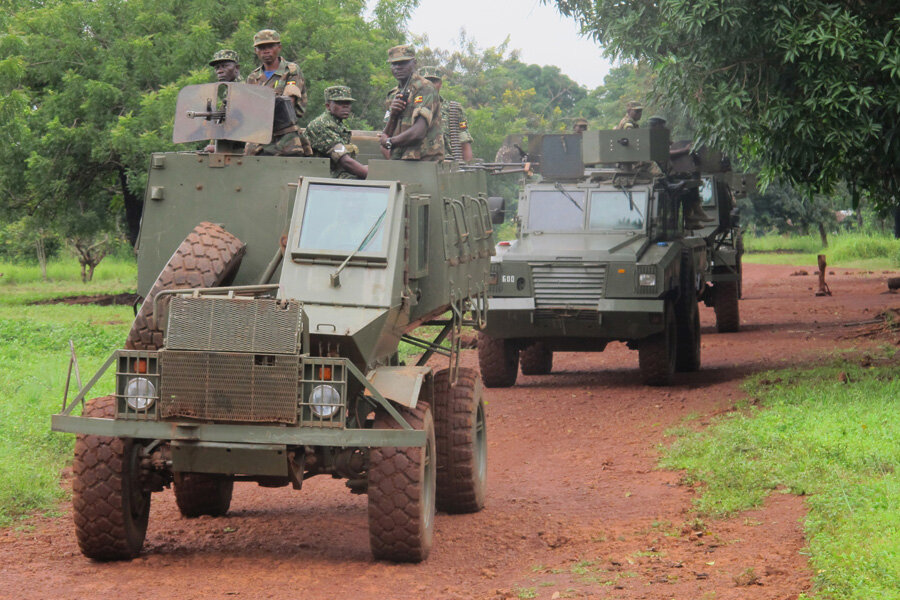Will clashes in Central African Republic thwart UN peace mission?
Loading...
A version of this post appeared on The Resolve. The views expressed are the author's own.
Reuters reports that Ugandan and Seleka troops are clashing in eastern Central African Republic, leaving scores of Seleka soldiers and several Ugandan troops dead.
The clashes have taken place near Nzako, a small mining town located in the CAR's Mbomou prefecture that has been a hotbed of Lord's Resistance Army (LRA) activity in the past year.
Since the clashes, tensions between the Uganda People's Defense Force (UPDF) and Seleka have escalated. Initially, Seleka officials claimed that UPDF troops had mistaken their forces for LRA rebels, which is almost certainly not true, but perhaps could have given both sides an opportunity to save face.
However, Ugandan military spokesman Paddy Ankunda, known for shooting from the hip, fed a series of surprisingly aggressive comments to the media by accusing Seleka forces of collaborating with the LRA, and claiming that Ugandan forces would treat them as enemies.
Seleka officials lashed back by accusing UPDF troops of plundering gold, diamonds, and ivory in the CAR.
The ongoing clashes bring to a head long-simmering tensions between the UPDF and Seleka.*
The UPDF was already unhappy about the Seleka overthrow of former Central African President François Bozizé in March 2013. President Bozizé had given Ugandan troops a (mostly) free hand to conduct counter-LRA operations in vast swaths of eastern CAR.
But Uganda found very little rapport with Bozizé’s replacement, Seleka leader Michel Djotodia, and worried about ties between Seleka leaders and the Sudanese government.
Mr. Djotodia angered the Ugandans further in late 2013 when he desperately tried to shore up his international image by giving supplies to an LRA group near Nzako that claimed Kony was interested in surrendering. Weeks later, Ugandan troops battled with the same LRA group, recovering some supplies they had received from Central African authorities before skipping out on the “negotiations.”
The rather complex dance between the UPDF, Seleka, and LRA in the Nzako area has continued in recent months. Several Ugandan LRA fighters have defected there since January, including the senior and respected LRA officer Sam Opio, who escaped last week.
Paddy Ankunda hinted that recent testimony from LRA fighters indicates Seleka forces in Nzako are periodically trading with LRA groups, perhaps in ivory and other illicit goods.
However, as my colleague Ledio Cakaj points out, the Seleka officers involved are likely acting on opportunistic self-interest rather than in response to strategic directives from their superiors.
Though Kony is not believed to be among the LRA commanders operating near Nzako, the area is one of the few in the CAR where the UPDF has had frequent intelligence on LRA group movements. Ugandan troops have quietly concentrated much of their recent operations there, staging from a series of small camps scattered in remote forests and rural villages where Seleka forces are not deployed.
In addition to collecting LRA defectors, they killed LRA commander Sam Kangul east of Nzako in November 2013 and captured a junior LRA officer nearby in April 2014.
But the renewed clashes with Seleka and subsequent war of words could jeopardize what has been a bright spot for counter-LRA operations.
It won’t be surprising if the UPDF withdraws troops from remote staging bases to more secure bases in southeast CAR where Seleka forces are not deployed. The new clashes could also prompt the US military to impose more restrictions on the movements of US troops advising the UPDF, who have been able to collect valuable intelligence during forays into small Central African towns in recent months.
The clashes will also complicate ongoing discussions between Uganda, the UN, and the African Union (AU) about the possibility of rehatting some Ugandan troops for peacekeeping forces in the CAR.
Uganda is facing shortfalls in its military budget (thanks in part to its deployments in South Sudan) and has expressed interest in deploying troops with the AU peacekeeping force in the CAR (MISCA), which will transition to a UN force (MINUSCA) in mid-September.
International donors would foot the bill for the deployment of any rehatted UPDF troops, a perk Uganda doesn’t currently enjoy as a member of the AU regional force tasked with pursuing the LRA.
There were a number of obstacles to such a move already, including concern that MINUSCA already has enough commitments for infantry troops and that peacekeepers are more urgently needed in areas further west in the CAR where the LRA does not operate.
Even if Uganda doesn’t rehat its troops, it must still coordinate with peacekeeping forces in eastern CAR. The LRA’s steady push deeper into the CAR in recent years has placed it squarely in areas currently controlled by Seleka rebels where peacekeepers sent to CAR may soon seek to deploy.
If Ugandan troops, with their aggressive mandate to pursue LRA forces, start treating Seleka forces as “the enemy,” they may undermine the more conservative UN peacekeeping forces seeking to protect civilians and stabilize the region.
Hopefully, cooler heads will prevail, allowing the activities of the UPDF and UN peacekeepers to be mutually reinforcing.
* In 2010 Ugandan troops deployed in the CAR town of Sam Ouandja angered local UFDR rebels by disrupting their stranglehold over diamond mines and prohibiting extortion of civilians. The tension was one of the factors that led Bozizé to ask the Ugandans to leave Sam Ouandja later that year. The senior UFDR officer in the area at the time, General Damane, later rose to power with Seleka and was Djotodia's liaison to the LRA group claiming Kony would surrender in Nzako in late 2013. (He did not.)







